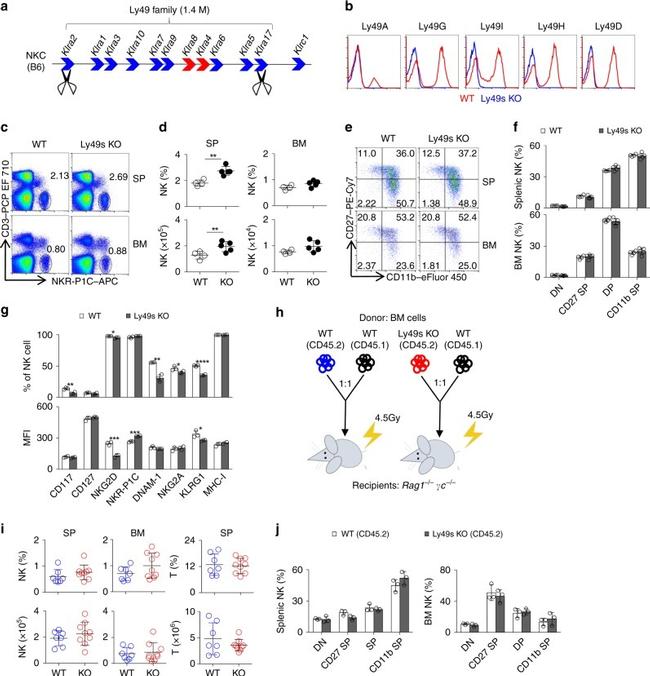 全部商品分类
全部商品分类



 下载产品说明书
下载产品说明书 下载COA
下载COA 下载SDS
下载SDS 用小程序,查商品更便捷
用小程序,查商品更便捷


 收藏
收藏
 对比
对比 咨询
咨询
种属反应
已发表种属
宿主/亚型
分类
类型
克隆号
偶联物
激发/发射光谱
形式
浓度
纯化类型
保存液
内含物
保存条件
运输条件
RRID
产品详细信息
Description: This A1 monoclonal antibody reacts with Ly49A, a 44-kDa member of the Ly49 family of type II transmembrane receptors expressed on natural killer (NK) cells. This receptor is present as a disulfide-linked homodimer with C-type lectin extracellular domains. An inhibitory receptor, Ly49A binds MHC class I molecules, such as H-2Dd, H-2Dk, and H-2DP, to inhibit NK-mediated cytotoxicity by triggering phosphorylation of its ITIM domain and recruitment of SHP-1 and SHP-2. Ly49A is expressed on DX5+CD3- NK cells and DX5+CD3+ NK T cells, as well as on a population of memory CD8+ T cells in C57BL/6, C57BL/10, and B10 congenic mice.
Applications Reported: This A1 (Ly49A) antibody has been reported for use in flow cytometric analysis.
Applications Tested: This A1 (Ly49A) antibody has been tested by flow cytometric analysis on C57Bl/6 splenocytes. This can be used at less than or equal to 0.5 µg per test. A test is defined as the amount (µg) of antibody that will stain a cell sample in a final volume of 100 µL. Cell number should be determined empirically but can range from 10^5 to 10^8 cells/test. It is recommended that the antibody be carefully titrated for optimal performance in the assay of interest.
Excitation: 488-561 nm; Emission: 578 nm; Laser: Blue Laser, Green Laser, Yellow-Green Laser.
Filtration: 0.2 µm post-manufacturing filtered.
靶标信息
Ly49A is a gene that encodes a protein expressed on the surface of natural killer cells, which is involved in recognizing and eliminating virally infected or cancerous cells. It is located on chromosome 6 and is part of a larger family of genes that encode for similar receptors. The Ly49A protein interacts with a variety of ligands, including certain viruses and tumor cells, and is involved in regulating the activation and function of natural killer cells. Mutations or variations in the Ly49A gene have been associated with various diseases and conditions, including autoimmune disorders and cancer.
仅用于科研。不用于诊断过程。未经明确授权不得转售。
生物信息学
蛋白别名: class I MHC receptor KLRA22; KLRA#; ly-49a; lymphocyte antigen 49a; natural killer cell receptor Ly49A; novel killer cell lectin-like receptor subfamily A protein; t lymphocyte antigen A1; T-cell surface glycoprotein YE1/48
基因别名: A1; CH29-493D4.3; Klra22; Ly49a; Ly49o<129>; Ly49v
Entrez Gene ID:(Mouse) 16627
参考图片
Staining of CD3- (Product # 11-0031-82) C57BL/6 splenocytes with Anti-Mouse CD49b (Integrin alpha 2) APC (Product # 17-5971-82) and 0.125 µg of Mouse IgG2a kappa Isotype Control PE (Product # 12-4724-81) (left) or 0.25 µg of Anti-Mouse Ly-49A PE (right).
Fig. 1 Ly49 family is dispensable for NK-cell development. a Diagram of Ly49-family genes in the NKC locus. Blue filled arrows denote inhibitory receptors and red filled arrows denote activating receptors. Scissors represent CRISPR gRNAs. b Flow cytometry analysis of the expression of Ly49-family receptors on splenic NK cells (gated CD3 - NKR-P1C + ) from WT (red line) and Ly49s KO (blue line) mice. c , d Representative flow cytometry plots ( c ) and quantification ( d ) of NK cells (gated CD3 - NKR-P1C + ) in the spleen (SP) and bone marrow (BM) of WT and Ly49s KO mice. e , f Representative flow cytometry plots ( e ) and percentages ( f ) of gated CD3 - NKR-P1C + NK cells in the four stages of development, including DN (CD27 - CD11b - ), CD27 SP (CD27 + CD11b - ), DP (CD27 + CD11b + ) and CD11b SP (CD27 - CD11b + ), in the spleen and BM from WT and Ly49s KO mice. g The percentage and mean fluorescence index (MFI) of the indicated molecules in gated splenic CD3 - NKR-P1C + NK cells except NKR-P1C and NKp46 in gated splenic CD3 - CD122 + NK precursor cells from WT and Ly49s KO mice. h Experimental design of bone marrow chimera assay. i Quantification of NK cells (gated CD45.2 + CD3 - NKR-P1C + ) and T cells (CD45.2 + CD3 + NKR-P1C - ) in the spleen and BM from chimeric recipient mice (7-9 mice pooled from two independent experiments). j Percentages of four NK-cell subsets (gated CD45.2 + CD3 - NKR-P1C + ) NK cells in the spleen and BM from chimeric recipie
Fig. 5 Ly49-family deletion does not rescue beta2M-null NK-cell function. a Flow cytometry analysis of the expression of Ly49-family receptors and NKG2A on splenic CD3 - NKp46 + NK cells from WT (red line) and beta2m -/- (blue line) mice; Ly49s KO mice (grey filled curve) served as the negative control. b Poly(I:C)-primed splenocytes from the indicated mice were stimulated with tumour target cells. Percentages of IFN-gamma + (left panel) and CD107a + (right panel) gated CD3 - NKp46 + NK cells were analysed. c In vivo rejection of beta2M-deficient splenocytes (similar to Fig. 3a ). Each symbol represents an individual mouse. Data shown represent two ( c ) or at least three ( b ) independent experiments. Mean +- SD is shown. * p < 0.05, ** p < 0.01, *** p < 0.001 and **** p < 0.0001. Unpaired Student's t -tests (two-tailed) was used to calculate these values. Source data are provided as a Source Data file






